Toilet device: structural and operational features
It is hard to imagine modern housing without a toilet, because this sanitary fixture makes visiting the restroom comfortable and does not require special care. However, for normal operation, the owner must know the device of the toilet bowl, since the faults of the toilet bowl and their elimination are directly related to its structural features.
We will tell you how the toilet is arranged, and also give some tips on how to set it up.

Design
Device and principle of operation
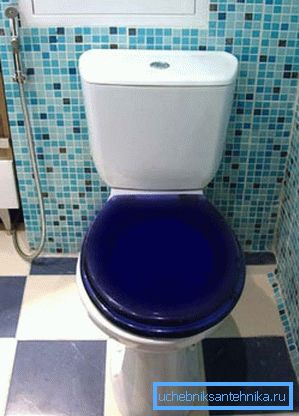
We will consider the most common model of “toilet-compact”, as it is familiar to everyone and quite intuitive.
The product consists of three main parts:
- Bowls, which is a container for collecting waste products. The bowl has a drain hole connected to the sewer riser and equipped with a water trap (siphon);
- Drain tank, which is necessary for the supply of water, which is used to drain the contents of the bowl in the sewer. Inside the tank, an automatic toilet flush device is installed, which regulates the operation of valves and stop valves;
- Stool with cover. Increases the usability of the device, and also allows you to close the container after use as intended.
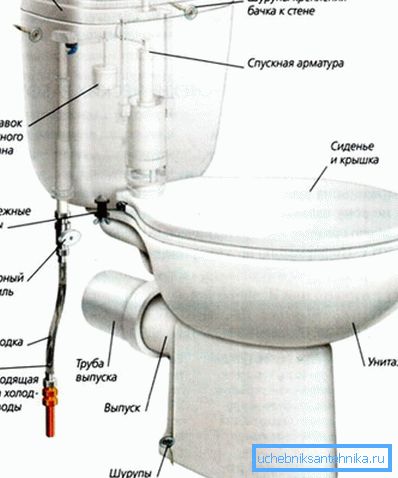
The device works as follows: water from the water supply system is fed into the tank through the toilet drain device, which includes a supply valve with a float mechanism.
As the tank is filled, the float rises and the supply valve closes, water stops flowing.
After use, the consumer presses a key or lever that turns on the toilet drain, the flush valve opens, and the water rushes into the bowl, washing its contents into a funnel pipe.
The amount of water is calculated by the manufacturer so that it is enough to completely remove feces from the bowl.
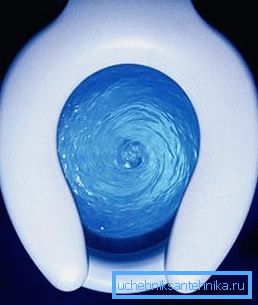
As the water level decreases, the float drops and the water supply valve opens again.
The incoming fluid presses on the petal of the drain valve, which closes the drain hole, and the water begins to accumulate again in the tank.
This occurs until its level reaches the set maximum, which will lead to the locking of the supply valve by the float, and the device will be clean and ready for use again.
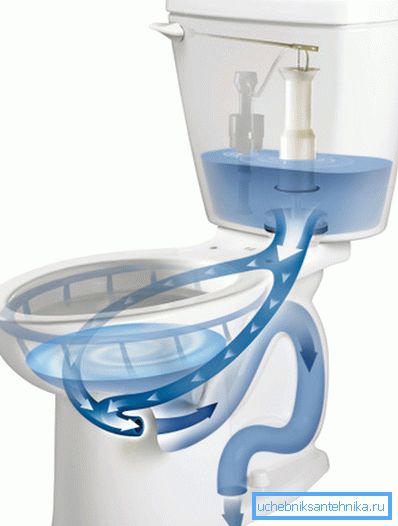
Note! In case of breakage of the float mechanism, a tank is provided with a system of overflow of excess water into the sewage system. This protects the owners of the apartment from flooding.
Toilet bowl
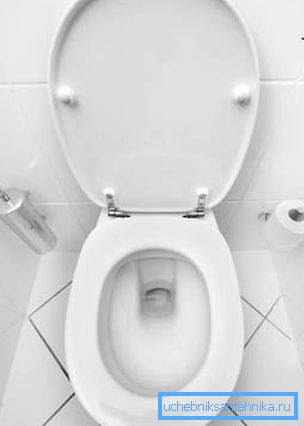
The vase of the device is designed so that its shape provides the most complete cleaning of the tank with minimal water flow from the tank. This allows not only to save liquid, but also to use more compact tanks.
Today there are three main varieties of this part:
- Disc. It has a flat shape, and the hole is biased forward, which saves us from ricochet sprays during the coping;
- Visor. Here the hole is shifted back, and the front wall is angled. This is the most convenient and aesthetic form of the vase;
- Funnel-shaped. The front and rear walls have approximately the same angle of inclination. The hole is located almost in the center of the bowl, which makes it the least comfortable because of ricochet sprays.

The contents are drained along the drain channel, which has a special form: due to the vertical bend (knee), a water trap is created in the channel.
After the fluid passes through the channel, a certain amount of it remains in the knee and blocks the access of sewage gases to the room.
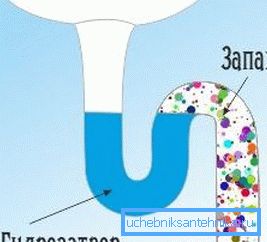
Also, the vases may differ in the location of the drain pipe: it can be horizontal, vertical or oblique.
This does not affect the operation of the device, but when connected to the riser, this feature is very significant.
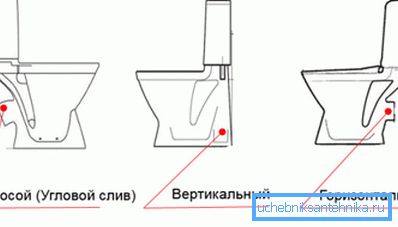
Note! When choosing a toilet bowl should study the location of the riser and fan tee. Usually buy a device with the same type of pipe that was on the old toilet.
Cistern
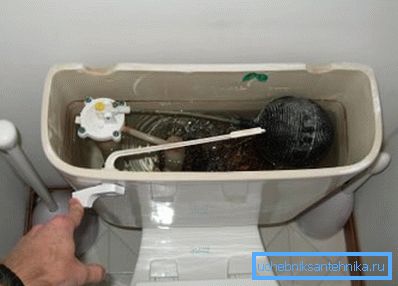
As mentioned above, the tank is designed to drain the contents of the bowl in the sewer. Modern tanks are equipped with mechanics, which performs automatic operation of the device.
The product has a main part and a removable cover, on which in the vast majority of models there is a water drain button.
As a rule, the tank is made of the same material as the entire appliance: faience or porcelain. Earlier, cast iron and steel tanks were produced, now plastic containers are sometimes found.
However, porcelain products are considered to be of the highest quality, and this applies to both the tank and the vase.

In the “compact” model, the tank is installed on a bowl and fixed with plastic or metal bolts with nuts.
The connection is equipped with a special rubber gasket, which makes it airtight. Sometimes the tank has an additional attachment to the wall.

There are also monolithic models in which the tank is inseparable from the bowl. In the old and some modern varieties of capacity is located above and connected to the vase with a vertical pipe.
Finally, there are hidden tanks that are fixed on the installation frame for wall mounting the toilet bowl.
Drain mechanics

Let's look at the design of the tank in more detail:
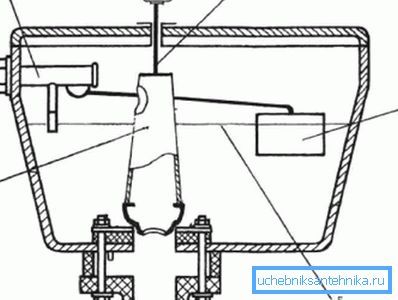
The composition of the drain mechanism includes:
- The valve of water supply with the float-operated locking mechanism. Shuts off and opens the channel for the flow of fluid, depending on the position of the float (water level);
- Overflow pipe (siphon), combined with a flush valve and a pear, closing the drain hole;
- Thrust to lift the pear and open the hole for flushing;
- A float that is connected by a needle to a feed valve. When moving the float up the needle presses on the membrane, which closes the channel of water entering the tank;
- Water level in the tank.
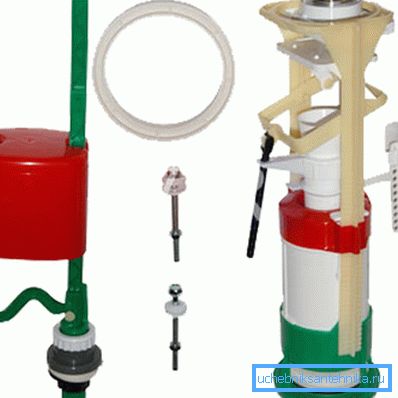
Note! Modern mechanics is somewhat different, but the principle of its action remains the same. We use the old scheme for clarity.
A device for draining water in the toilet allows you to adjust the amount of fluid accumulated by the tank. To do this, a screw is located in the supply valve, whose rotation changes the position of the spokes of the float, at which the channel is locked.
You can also adjust the level by changing the shape of the needle: for this you can bend it or use the knee joint, if it is provided for by the design.
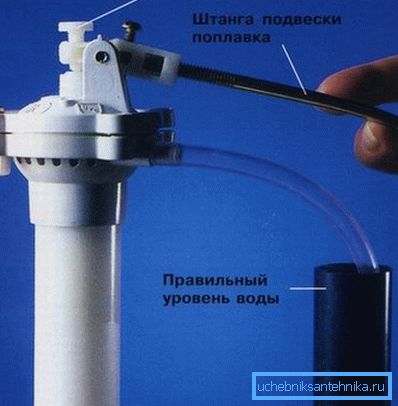
Note! During the breakdown of mechanics or insufficient flushing do not rush to write off the system. Before you change the drain in the toilet, check its setting, as well as the condition of the rubber gaskets and valve diaphragm.
Instructions for setting up mechanics can vary greatly depending on its configuration, since modern instruments are distinguished by improved control systems.
However, it is worth noting that the newer the device, the easier it is to configure it, so there is no need to worry.

There is also a flushing device under pressure for the toilet, which eliminates the storage tank.
However, for private housing, this solution is bad, because it requires a direct connection of an inch or? highway to the toilet, which is poorly consistent with the characteristics of the internal wiring of cold water pipes.
In addition, this design is very noisy and creates water hammer in the network.
Conclusion
The price of good plumbing is quite high, and when choosing it, it is advisable to understand the toilet bowl device. Also, this knowledge will help to properly configure and operate the device comfortably, and the video in this article will help you with this.